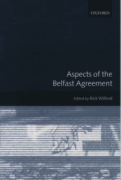Published as a contribution to Aspects of the Belfast Agreement (ed. by Rick Wilford, Oxford University Press, 2001), this chapter takes as its starting point the observation that both the 1973 Sunningdale and 1998 Belfast agreements are, in essence, consociational settlements with a strong cross-border dimension. However, there are also significant differences between them, both in terms of content and the circumstances surrounding their negotiation, implementation, and operation. These differences are important since they shed light on why the Sunningdale Agreement failed whereas the Belfast Agreement seems to have a reasonable chance of success.
In order to provide a structure for the analysis of these differences, I initially outline the criteria that determine whether or not a consociational settlement with a strong cross-border dimension can provide long-term stability and peace in situations of intense intergroup conflict. This is followed by a brief comparison of the content of the two agreements and a more detailed examination of the reasons for the failure of Sunningdale and the apparent success of the Belfast Agreement.

